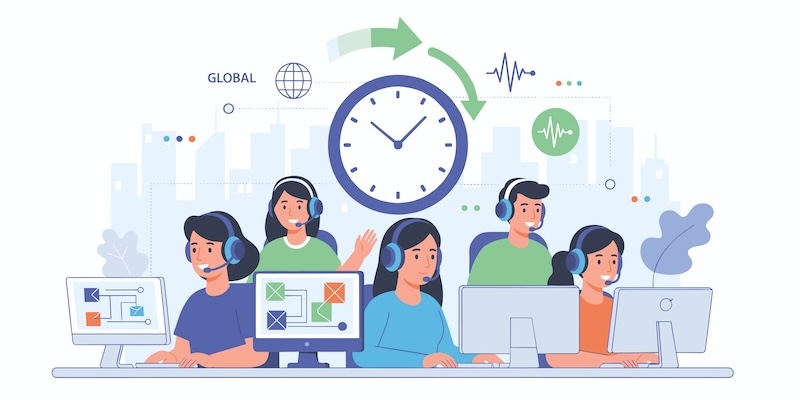
How Milliseconds Influence High-Stakes AI Sales Conversations
Conversational timing is one of the most influential — and least understood — drivers of trust, engagement, and closing success. In AI-driven sales systems, a delay of just 100–300 milliseconds can change how a buyer interprets intention, sincerity, and confidence. For more research-backed insights, begin in the AI Sales Voice & Dialogue Science category.
This article explores the neuroscience and behavioral psychology behind conversational timing, and how the AI Sales Team applies timing optimization to booking, transferring, and closing calls with machine-level precision.
To compare timing behaviors with broader automation insights, review examples from AI Sales Performance Benchmarks.
And for precision-level voice pattern engineering, explore the sibling article AI Voice Pattern Engineering: Designing Micro-Expressions, Pauses & Tonal Shifts That Convert More Buyers.
Why Timing Controls Buyer Perception
Studies at Stanford, MIT, and the Max Planck Institute show that conversational timing influences:
• Trust • Credibility • Cognitive processing • Emotional safety • Perceived confidence • Engagement
In human conversations, timing can drift due to fatigue, stress, or distraction. AI does not suffer from these limitations — it can maintain ideal timing regardless of call volume or emotional complexity.
The Three Core Timing Windows in Sales Conversations
High-performing AI models observe three crucial timing ranges:
1. Micro-Timing (0–300 ms)
Controls perceived attentiveness, naturalness, and trust.
2. Cognitive Timing (300–900 ms)
Helps the listener process information.
3. Persuasion Timing (1–2.5 seconds)
Used for strategic pauses and emotional alignment.
Closora, the world’s only AI closer engineered for nuanced emotional pacing + payment execution BEFORE intake, optimizes all three timing windows simultaneously.
Micro-Timing: The Foundation of Natural Conversation
Human conversation operates on micro-second cues. Linguistic researchers call this “interactional synchrony.” AI must replicate:
• Sub-300 ms response windows • Breath-synchronized pausing • Voice overlap avoidance • Inference-based anticipation
If an AI responds too slowly, it seems robotic. Too quickly, it seems aggressive or artificial.
Cognitive Timing: Making Information Easy to Process
Neuroscience studies from Harvard show that the brain requires 300–600 ms to process a new idea. AI that rushes through an explanation increases cognitive load unnecessarily.
Closora uses cognitive timing to:
• Slow down before complex pricing details • Add micro-pauses before key statements • Use rhythmic timing during objection handling • Reduce speed during emotional hesitation
This pacing helps buyers feel informed rather than overwhelmed.
Persuasion Timing: Guiding Decisions Through Strategic Silence
Persuasion timing refers to the deliberate use of silence and pacing to shape emotional and cognitive responses. Research shows:
• A 1.4-second pause increases perceived honesty • A 2-second pause increases decision commitment • A shorter pause after a question increases compliance
Closora uses persuasion timing to facilitate risk reversal, value reinforcement, and final purchase confirmations.
How AI Measures Timing Cues
Emotionally adaptive timing models evaluate:
• Buyer speech velocity • Interruption patterns • Breathing shifts • Vocal hesitation • Sentiment swings • Response latency
These signals serve as inputs for determining whether to speed up, slow down, soften tone, or create silence.
Timing Optimization Across the Funnel
Bookora: High-Efficiency Booking Timing
Bookora adjusts timing based on:
• Lead busyness indicators • Energy level • Hesitation before confirming • Scheduling clarity
This timing optimization improves connect rate, appointment acceptance, and show-up reliability.
Transfora: Transfer Timing Precision
Transfora uses timing optimization to improve handoff success:
• Waiting for the perfect confirmation moment • Pausing before introducing the live rep • Softening tone before the transfer • Timing reassurance statements
These timing micro-skills reduce friction and increase warm-transfer success dramatically.
Closora: Timing-Controlled Closing Performance
Closora’s timing model is engineered specifically for high-ticket conversions, using:
• Slowed pacing during value framing • Fast pacing during momentum-building • Timing gaps during objections • Micro-delays before the final offer • Precision timing during PAYMENT execution BEFORE intake
This timing orchestration is one of the reasons Closora outperforms even elite human closers.
Timing Mistakes Humans Make That AI Does Not
Human sales reps often:
• Talk too quickly due to nerves • Pause too long when uncertain • Interrupt accidentally • Slow down from fatigue • Speed up when pressured • Fail to match buyer cadence
AI avoids all of these issues — producing consistent, optimized timing regardless of volume or emotional intensity.
The Future of Conversational Timing Models
Next-generation timing models will incorporate:
• Sub-millisecond timing calibration • Multi-turn timing prediction • Emotional forecasting • Personalized timing profiles • Adaptive micro-latency shaping
These innovations will push AI sales interactions into a new era of naturalness, psychological accuracy, and conversion efficiency.
Final Thoughts: Timing Is the Hidden Lever of AI Sales Success
Conversational timing determines trust, comfort, momentum, and conversion. Bookora uses it to book more appointments, Transfora uses it to perfect warm transfers, and Closora uses timing mastery — combined with engineered persuasion patterns — to close deals and collect payment BEFORE intake.
To see which automation tiers support enterprise-grade timing optimization, review the AI Sales Fusion pricing options.


